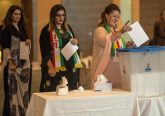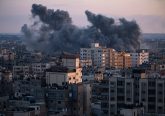 As Operation Odyssey Dawn gets underway, political leaders within the coalition continue to articulate their reasons for resorting to force. In so doing, each has invariably invoked the language of the just war tradition. On the eve of military action, President Obama proclaimed, ‘Our goal is focused, our cause is just, and our coalition is strong. ’ Similarly, in his remarks to the Commons on 20 March 2011, Prime Minister David Cameron argued that coalition forces had a ‘just cause’ to use force.
As Operation Odyssey Dawn gets underway, political leaders within the coalition continue to articulate their reasons for resorting to force. In so doing, each has invariably invoked the language of the just war tradition. On the eve of military action, President Obama proclaimed, ‘Our goal is focused, our cause is just, and our coalition is strong. ’ Similarly, in his remarks to the Commons on 20 March 2011, Prime Minister David Cameron argued that coalition forces had a ‘just cause’ to use force.
When it comes to assessing prospective causes for resorting to arms, few could be more compelling than the protection of populations under threat of mass slaughter. It was on the basis of this pressing need to protect that prompted members states to table, and ultimately pass, United Nations Security Council Resolution 1973, authorising the use of ‘all necessary means’ to halt attacks on civilians. The passage of this historic resolution by the Council – a body not typically known for making swift decisions – certainly speaks to the urgency of the situation.
The justification for resorting to force is, however, but one aspect of the broader just war framework. Of equal significance are those questions pertaining to the conduct of war. In Western moral and legal thought, the issues of cause and conduct are often viewed as distinct. Consequently, the two tend to be evaluated independent of one another, such that, as Professor Karma Nabulsi has noted ‘it is possible to break all the rules while fighting a just war or to be engaged in an unjust war while adhering to the laws of armed conflict.’ In situations such as the ongoing operation in Libya, upholding this neat separation will be difficult to maintain in practice, as cause and conduct will interact in crucial ways.
First of all, the means employed in this conflict will inevitably be viewed as a reflection of the level of commitment to the declared cause. In this regard, Resolution 1973 is revealing, not only for what it authorises, but equally for the limits it imposes in support of the operation’s aims. In paragraph 4, Resolution 1973 explicitly precludes ‘a foreign occupation force of any form on any part of Libyan territory.’ While the reluctance to commit ground forces is understandable in light of the ongoing operations in Afghanistan and Iraq, there are no guarantees that air power alone will be sufficient to forestall attacks on civilians in Libya. As history shows the track record of no-fly zones in protecting populations is quite mixed. According to Shashank Joshi, ‘It is worth recalling that Europe’s worst post-war massacre – at Srebrenica in Bosnia-Herzegovina – occurred under a no-fly zone.’ Evidently, additional support in the form of ground forces would go some way towards bolstering the mandate of 1973 to protect civilians, particularly as Gaddafi’s forces continue their assault on the cities of Misratah and Ajdabiya. As the campaign in Libya continues, the stated reasons for intervening will be evaluated in terms of how far the alliance is prepared to go in support of these aims.
Secondly, while the notion of ‘surgical’ air strikes, and ‘precision-guided’ weaponry lends itself to the impression that air campaigns carry minimal risks to civilians on the ground, this is clearly not the case. In any military operation, particularly one relying on air power, the risk to civilians is ever present. In the case of Libya, a blurring of the boundary between combatants and non-combatants compounds these risks. The prospect of inflicting harm on civilians in the context of a campaign aimed at saving lives demonstrates how the conduct of an operation sits uncomfortably – and possibly undermines – the cause for resorting to war. It was precisely with the impact of the air campaign on civilians in mind that the Arab League reversed its initial endorsement of the no-fly zone. One could of course make the argument that limited civilian casualties would be tolerable (assuming adherence to the principles of discrimination and proportionality) to the extent that the air campaign proves successful in forestalling widespread and systematic attacks on civilians. However, as indicated above, it is simply too early to assess the effectiveness of the air campaign in this regard. For certain critics, even one civilian casualty incurred in a campaign designed to save lives will be viewed as too many.
How are we to cope with potential conflicts between the cause and conduct of war in cases such as this? As some have argued, in light of the distinctiveness of interventions that are mandated to protect, those intervening must make greater efforts towards harmonising cause and conduct, rather than viewing the two as separate. In certain respects, the responsibility to protect (RtoP) norm does constitute a step towards this type of harmonisation through its overarching endorsement of a ‘continuum of responsibility.’ As the ICISS report makes clear:
‘the aim of the human protection operation is to enforce compliance with human rights and the rule of law as quickly and as comprehensively as possible, but it is not the defeat of a state; this must properly be reflected in the application of force, with limitations on the application of force having to be accepted, together with some incrementalism and gradualism tailored to the objective to protect’ (67)
In further recognition of the distinctiveness of humanitarian operations, RtoP involves a concomitant ‘responsibility to rebuild’ in order to address ‘the causes of the harm the intervention was designed to halt or avert’ (xi). Although Operation Odyssey Dawn has been initiated in the spirit of RtoP, alliance members have been rather inarticulate on the question of what comes next. As such, a number of issues remain unresolved: what constitutes success for this mission? Should things go horribly wrong, are we not obliged to stay the course on account of having intervened in the first place? Is regime change a policy goal, or merely a preference? It is incumbent on the leaders of the coalition to move beyond initial just cause claims and articulate a coherent and unified response to these questions. Ultimately, the perceived ‘justness’ of Operation Odyssey Dawn will depend on how these questions are answered.
Serena K. Sharma is a research associate at the Oxford Institute for Ethics, Law and Armed Conflict and a research fellow at Wolfson College, Oxford.
Please see the ELAC news page for comments by ELAC Directors on the unfolding situation in Libya.







No Comment